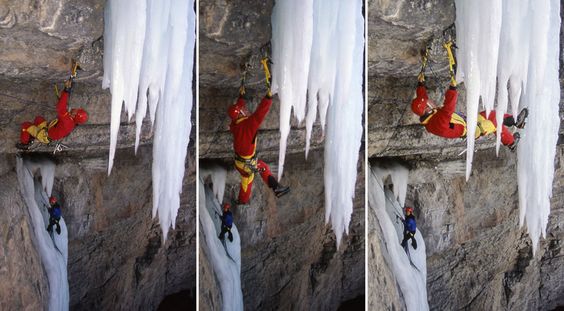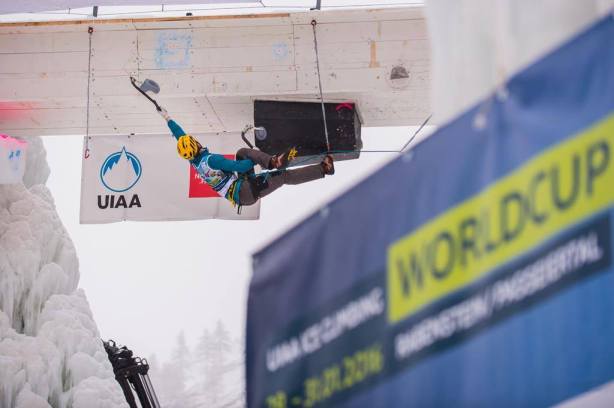Last week, amazing dry-tooling routes have been sent without Yaniros, called “D.T.S. way”. D13+ by Marianne and D15 by Tom.
AND the 21st of February 2016 I also sent this D15, A line above the sky, in Dolomites! Without Yaniros of course!!

AND THEN taking the advantage of this great shape and endurance, one month later I sent Iron Man in Eptingen! Without Yaniros of course!! Way more difficult for me than A line above the sky… It took me 7 tries to make it to the chain, so hard down-climb moves and poor feet on the roof with a random move at the end of this roof!
When I talk about dry-tooling with people, I am often asked that same bemused question: « Why do French climbers not use at all Yaniros?” (also called “figure 4”- see below). At the same time, I can’t help but to hear that same question echo in my head like « Why are the French stupid enough not to use Yaniros? » and so I feel like I have to enter into a detailed and well-argued answer.

Gaetan in the crux of the route « No Figure 4 » at Usine. Project!
But let’s have a closer look at it.
PS: I do not claim to hold the truth here; this is just what I could gather on the subject. Feel free to give me your comments or precisions on this matter.
What is a Yaniro ?
Used in the 80’s by rock-climbers, the Yaniro technique got its name in France in memory of Tony Yaniro who did an awesome show by performing such a movement at Buoux, on a route called Chouca, (F 8a +) in 1986 or 1987.

Tony Yaniro on the crux move of Chouca at Buoux
“Figure 4” is the name commonly used in English to designate that same technique, it is a movement with the leg over the arm (the knee over the wrist to be precise), then drawing a 4 with the opposite leg to the arm and a 9 with the leg on the same side then called “Figure 9”.

Gordon Mac Arthur doing a Figure 4
The Figure 9 is usually used after a Figure 4 allowing to always keep one leg on an ice-axe or for special move to reach even further.

Marianne Van der Steen doing a Figure 9
Figure 4 is the most effective technique to perform the classical movements.
This movement is useful in several situations:
– Lack of big obvious foot holds, which allows you to save energy without having to tense your body trying to keep our feet on tiny holds or in the roof.
– When there are tiny holds for ice-axe picks, allowing to be very stable to achieve long reaches and thus avoid to zip off.
History
It was probably used for the first time by the father of mixed climbing, Jeff Lowe in 1994 during his first ascent in M8 grade (Octopussy in Vail, Colorado) which he succeeded thanks to two Yaniros.

1994: Jeff Lowe in Octopussy, M8 in Vail, Colorado.
Crampons and heavy mountaineering boots (1kg per foot) made it difficult to progress on overhang and roof sections. Use of Yaniro was then a solution to avoid losing the feet off the rock and having trouble to get them back on in the roof.

Gaetan in 2007 with old straight ice-axes, mountain boots and alpine crampons in a D10 at Sanglier, France.
At that time the use of Yaniros was rare for the slightly overhanging routes, only relatively short roofs sections were climbed with this special movement but impractical to achieve with traditional ice-axes with leashes and big alpine heavy boots. At that time, I was only 13 years old and had just started rock-climbing …
Then the level continued to rise and the climbs were becoming more and more overhanging with less ice, i.e. dry-tooling by definition. The used of Yaniro increased just as much, whilst the weight of climbing gear was going down. It has been around over 15 years now that special dry-tooling boots exist, and they are now very light, precise and rigid with integrated points for less than 350g per foot and ergo ice-axes for a better grip while executing a Yaniro.

Ultra-light dry-tooling boot with special crampons
It is easier now to keep your feet in contact with the rock in big overhang and roofs. However, the Yaniro always allows an easier progression than without it. So climbers logically continued to use Yaniros it in their quest of « high-level ».
Look here Robert Jasper on the roof masterpiece « Iron man », famous D14 at Eptingen in Switzerland.
Today
Nevertheless, some people have always advocated an ethical style without Yaniro. Those people are to name a few: Jeff Mercier, Will Gadd and recently myself. It is in France that this style is the most developed, now called « French style » or D.T.S. (Dry-Tooling Style, named from the famous French annual contest which prohibits Yaniros).

Gaetan in « Castor et Pollux » D12 in Faverges, France.
There are several reasons why we do not do Yaniros:
– The use of feet on the rock is much more interesting, it looks like rock-climbing when it needs to find the right foot. So there is a technical dimension in addition, much less annoying than to chain Yaniros after Yaniros on during 20m roof.
– It allows long reaches with good holds.
– In the mountains nobody does Yaniros, since dry-tooling is considered only as a training activity, therefore doing this move in the mountains doesn’t make sens.
– Because we love the difficulty, the « French style » really makes dry-tooling more difficult by the need to keep feet in the roof and carried greater weight in the hands during movement (we get tired faster).

Jeff in « Superfortress » D13 in Vail, Colorado.
Look here Will Gadd on the masterpiece « The Mustang », last M14 at Vail.
Note: DTS is painfull for shoulders, so take it easy or use Figure 4 like Will now who has destroyed shoulders due to DTS…
Should we ban the use of Yaniros ?
Dry-tooling evolved pretty fast over the last 20 years: leashes disappeared, ergo ice-axes were developed, spurs disappeared, Yaniros, special light boots, longer ice-axes, etc … These developments were strongly led by competitions of the ice-climbing world cup, even though now it looks more like dry-tooling with just a few ice cubes hanging here and there just to make it look pretty.

Valentyn Sypavin on the roof at Rabenstein 2016 ice climbing world cup.
It is noted that the use of Yaniros in these competitions is increasingly rare because avoiding you go faster and further, yet it is an undeniable weapon on tiny holds and in the roofs.

Han Na Rai Song at Rabenstein 2016 ice climbing world cup.
Personally I am not against Yaniros because in dry-tooling and climbing in general there are no specific rules on how to climb. The goal is to have fun first. However, I do not agree with the generalization of doing Yaniro after Yaniro for all whole climbing sections (especially where it is obvious to use feet) because this method is too simplistic and technically repetitive. Don’t you think that it’s not boring? Look at this :
But we can also say the same for the « French style » that in the overhang or roof requires taking a swing at every movement, a bit repetitive too…

Gaetan on is project « No Figure Four » at Usine, France.
So what to do ?
Firstly, to do what we enjoy the most, regardless the grade of the route. I am therefore in favor of a wise and moderate use of Yaniro, that is to say in cases where it is impossible to pass without it due the lack of foot holds, and in roofs to avoid taking swings on 20m and destroy your shoulders.

Will Gadd trying the long roof of « No Figure Four » at Usine.
I will never know how to make a Yaniro. It is kind of my ethics and my stupid stubbornness but I accept not to be able to climb certain routes by lack of reach, endurance, stability or locking to hold on tiny crimps without Yaniro. From there comes my motivation to climb even more! And after all, as I do not do dry-tooling only for the sake of climbing harder grades it suits me perfectly, as my arms are always totally knackered at the end of the day.

Gaetan showing that it is possible to reach very far without Figure 4 in a D13 at Barrio, France
And you ? Are you pro or against the use of Yaniros ??

Gaetan doing DTS (left) and Gordon doing Figure 4 (right) on the same move in « No Figure Four » at Usine.
Bonus: EPIC TV Episode at Usine









Thanks for your article! I saw,in the newly released video of you and Angelika Rainer on Tom Ballard’s D15 that while Angelika used some figure 4, you didn’t! Congratulations, you made it to the Roof 🙂 🙂